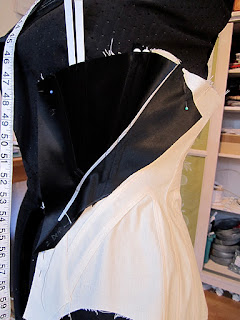One way to take your corsetry to the next level, is to sew as many historical patterns as possible. I've got a stack to get through, some from old patents, some scaled up from books and some drawn by corsetiers who own antiques, such as this one from Atelier Sylphe. This pattern is from the period c.1902-1905 and therefore an early Edwardian corset - my favourite style because of the curved seams, flat front and beautiful hip shaping of that era.
 |
| Atelier Sylphe |
Atelier Sylphe patterns come with some very basic instructions and a ton of pictures supplied electronically detailing every seam, every angle, every minute detail of the original antique corset, so that the experienced corset maker can figure out how to sew it together. It's not as hard as it sounds once you get down to it, but I found that pinning the paper pattern complete with bone channel guidelines together first, acts as a great reference and guide to sewing the toile - you can make notes on it as you go so that you have a 'live' reference when you come to sew the final version.
Edwardian corsets are generally single layer garments with curved lapped seams, bust and hip gussets, and vertical bone channels sewn to the inside over the curved construction seams.
I made one calico toile, sewing each side together separately and making improvements each time. I then collected some coutil scraps and made a section of the pattern to see how the design reacted to much stiffer fabric, and added a little piping experiment. Quite happy with the results I cut the corset in coutil and made up one side with silver piping at the main curved seams.
Black satin coutil is extremely unforgiving - it shows up every single tiny mark, every pin prick, every crease, and to make matters worse, it is a devil to stitch - the glare of the shiny surface with black stitching is an eyeache.
However, the result is extremely pleasing, and although hard on the eyes when stitching, satin coutil is very easy to sew and gives the corset a lovely crisp appearance and feel with a really beautiful lustre.
The piping is polyester - all I had in the correct colour. I'm not convinced. Will have to try silk fabric for the piping - it's thicker than polyester so the 'rope' pattern of the piping cord wont show through, and it will be less slippy to sew. However the other reason i'm not sure about the piping is because of the way the boning channels must be sewn perpendicular to the curved seams and therefore over the piping at an almost 45 degree angle. It might therefore be better to construct the corset in a different way which means that the vertical bone channels are sewn invisibly to a lining.
I do love this pattern. The way it has been drafted is excellent - every line perfectly matched so that the corset, once you have worked it out, is actually really easy to sew. The detail is fabulous, the shape lovely. I'm going to sew the other side in a different style - closer to the original, without piping but with contrast stitching.
My blog posts will be quite intermittent over the next few weeks but I will keep you posted, and I do have a little giveaway to tell you about soon.









